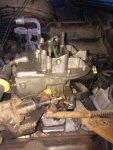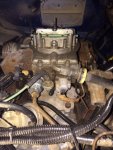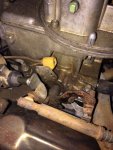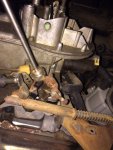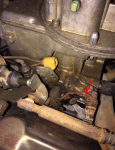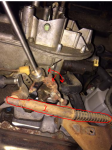1 1/2 turns is not a good setting, I know the factory manual says that, as steps for a carb rebuild, but it is incorrect. I use the propane enrichment method to set idle mixture. The start point for this is 2 3/4 turns backed out. There is a warning that if you have to go in less than 2 1/4 or out more than 3 1/4 there is likely an internal carburetor malfunction.
The carburetor is bolted to an EGR spacer that sits between the carburetor and the intake manifold. There is a vacuum port on the front of this, maybe 3" directly below the enrichment value.
Ford carburetor rebuild kits did not include a power valve, due to the different calibrations that could be rebuilt with the same kit. If you buy an aftermarket kit, it's going to have a Holley 6.5 in/Hg valve, it will be a different design from the original, and the original style gasket will block (or at least occlude) the flow of fuel. The factory valve CE-106 (D5AZ-9A565-A) is set to open at 5-6 in/hg and has four holes that sit above the gasket to flow fuel. There is a later revision of the Motorcraft enrichment valve that is similar to the Holley included in today's rebuild kits, with two square ports to flow fuel--I would avoid these.
With rebuilt parts, there is a lot of consolidation of part numbers. You'll be better off sticking with the original carb, and original components.
